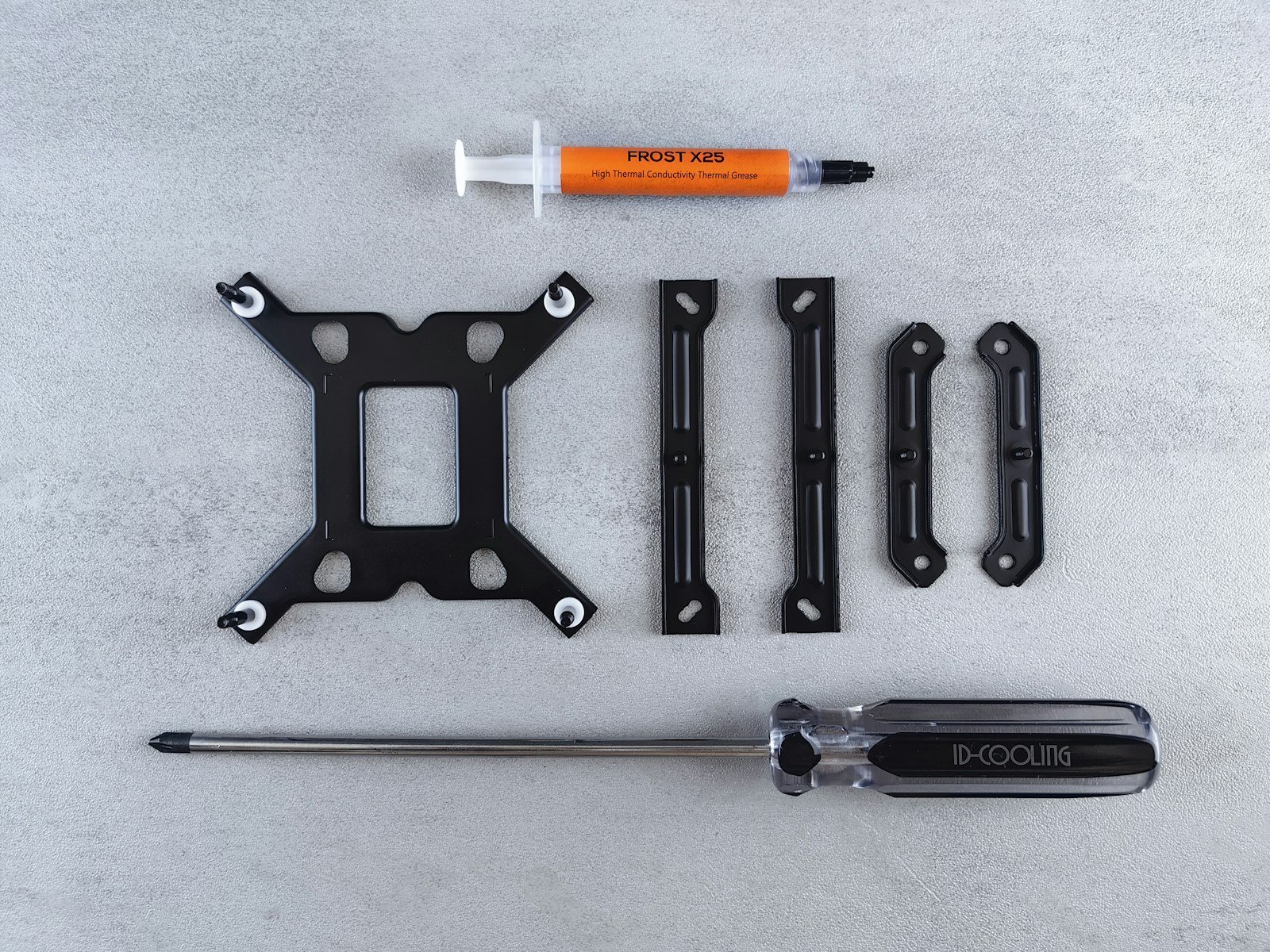Applying thermal paste correctly is a crucial step in building or maintaining your computer. This simple substance creates a thermal bridge between your CPU and cooler, allowing heat to transfer efficiently. The right amount and application method of thermal paste can significantly improve your system’s cooling performance and extend the life of your processor.
Many PC builders fear applying thermal paste, worried they’ll use too much or too little. The good news is that it’s actually quite simple. The most common method involves placing a pea-sized dot in the center of the CPU, which spreads evenly when the cooler is installed. For larger processors like Threadripper, a different pattern with multiple small dots works better.
Getting this right matters because poor thermal paste application can lead to overheating. When your CPU runs hot, it may throttle performance or even shut down to protect itself. With clean surfaces and the proper technique, you’ll ensure optimal heat transfer between your processor and cooling solution.
How to Apply Thermal Paste Correctly for Optimal CPU Cooling
Applying thermal paste correctly is crucial for effective heat transfer between your CPU and its cooler, ensuring your processor stays cool and performs optimally. Improper application can lead to higher temperatures, system instability, or even hardware damage. This guide walks you through the steps to apply thermal paste properly.
What You’ll Need
- Thermal paste (high-quality, preferably from a reputable brand)
- Isopropyl alcohol (90% or higher) and lint-free cloth or coffee filters
- CPU cooler
- Screwdriver (if needed to remove/install cooler)
- Latex or nitrile gloves (optional, to keep things clean)
Step-by-Step Guide
1. Prepare Your Workspace and Components
- Power down your PC and unplug it.
- Remove the side panel of your computer case to access the CPU.
- If you’re replacing thermal paste, carefully remove the CPU cooler.
2. Clean the CPU and Cooler Base
- Use a lint-free cloth or coffee filter moistened with isopropyl alcohol to gently clean off old thermal paste from the CPU heat spreader and the base of the cooler.
- Make sure both surfaces are completely clean and dry before proceeding.
3. Apply the Thermal Paste
There are several popular methods to apply thermal paste. The goal is to create a thin, even layer that fills microscopic gaps without excess spillage.
Recommended Method: The Pea-Sized Dot
- Squeeze a small pea-sized amount (about 4-5mm diameter) of thermal paste onto the center of the CPU heat spreader.
- Avoid spreading it manually; the pressure from the cooler will spread it evenly.
Other methods include a thin line or an “X” shape, but the pea-sized dot is simple and effective for most CPUs.
4. Install the CPU Cooler
- Carefully place the cooler onto the CPU, aligning it properly.
- Apply even pressure and secure the cooler according to the manufacturer’s instructions (usually by tightening screws in a diagonal pattern).
- Avoid lifting or shifting the cooler once it touches the paste to prevent air bubbles.
5. Reassemble and Test
- Reattach your PC case side panel.
- Power on your system and monitor CPU temperatures using software like HWMonitor or Core Temp.
- Ideal idle temperatures vary by CPU, but generally, anything below 40°C is good, and under full load, staying below 80°C is recommended.
Tips for Optimal Results
- Use high-quality thermal paste with good thermal conductivity.
- Don’t use too much paste; excess can spill over and reduce effectiveness.
- If you’re unsure, reapply rather than risk a thick or uneven layer.
- Replace thermal paste every 2-3 years or if you remove the cooler.
- Ensure your CPU cooler is compatible and properly mounted.
Applying thermal paste correctly can significantly improve your CPU’s cooling performance and longevity. Follow these steps carefully to keep your system running cool and stable.
Key Takeaways
- A pea-sized amount of thermal paste in the center works for most CPUs, while larger processors may need multiple small dots.
- Clean both the CPU and cooler surfaces thoroughly before applying new thermal paste.
- Proper thermal paste application helps prevent overheating and maintains optimal system performance.
Understanding Thermal Paste and Its Function
Thermal paste plays a crucial role in computer cooling systems by filling microscopic gaps between the CPU and heatsink. This specialized material ensures efficient heat transfer, preventing potential damage from overheating and maintaining optimal performance.
What Is Thermal Paste?
Thermal paste, also called thermal compound or thermal interface material (TIM), is a thermally conductive substance applied between two metal surfaces like a CPU and its heatsink. It’s designed to fill tiny air gaps that naturally exist between these surfaces.
Even perfectly machined metal surfaces have microscopic imperfections invisible to the naked eye. These imperfections trap air, which is a poor heat conductor.
Thermal paste has a much higher thermal conductivity than air. When properly applied, it replaces these air pockets with a material that transfers heat more efficiently.
Most thermal pastes consist of a base material (often silicone) mixed with thermally conductive particles like silver, aluminum, or ceramic compounds. Different formulations offer varying levels of thermal conductivity and longevity.
Roles of Thermal Interface Materials (TIM)
The primary function of thermal paste is to enhance heat dissipation from the CPU to the cooling system. Without it, a CPU would quickly overheat and potentially suffer permanent damage.
Heat generated by the processor needs a clear path to the heatsink. Thermal paste creates this path by eliminating air gaps between the surfaces.
Key benefits include:
- Improved thermal conductivity between surfaces
- Prevention of air pockets that inhibit heat transfer
- Extended component lifespan through better temperature management
- Stabilized CPU temperatures under load
Thermal paste doesn’t last forever. Over time, it can dry out, crack, or degrade in performance. When this happens, temperatures rise, potentially causing system instability or throttling where the CPU reduces its performance to avoid damage.
Preparing to Apply Thermal Paste
Before applying thermal paste, proper preparation is essential for optimal results. Having the right tools and taking safety precautions will ensure the process goes smoothly and effectively.
Essential Tools and Materials
To apply thermal paste correctly, you’ll need several key items. First, select a high-quality thermal paste like Arctic MX-4, which offers excellent heat transfer properties and longevity.
You’ll also need:
- Isopropyl alcohol (90% or higher)
- Lint-free microfiber cloths
- Plastic scraper or old credit card for spreading (optional)
- Non-static gloves to prevent oils from your fingers transferring to components
Some thermal pastes come with a plastic spreader tool. If not, you can use a plastic card or purchase a dedicated spreading tool. For cleaning the CPU or GPU surface, cotton swabs can help reach tight areas around the processor.
Safety Precautions and Preparations
Always power down the computer completely and unplug it before beginning work. This protects both you and sensitive components from electrical damage.
The CPU or GPU surface must be completely clean before applying new thermal paste. Use isopropyl alcohol and a lint-free cloth to remove old paste from both the processor and heatsink contact surfaces. Any residue can create air pockets that reduce heat transfer efficiency.
Wearing non-static gloves prevents skin oils from contaminating surfaces. Work in a well-ventilated, dust-free environment to avoid contaminants settling on components.
Allow cleaned surfaces to dry completely before applying new paste. Even small amounts of moisture can affect thermal performance or potentially damage components.
Applying Thermal Paste Step by Step
Properly applying thermal paste ensures optimal heat transfer between your CPU and cooler. The right technique prevents overheating while avoiding waste of thermal material.
Proper Application Techniques
For most CPUs, the pea method works best. Place a small pea-sized dot (about 3-4mm) in the center of the CPU. When the cooler is attached, pressure will spread the paste evenly across the surface.
For larger CPUs like Intel’s 12th-14th Gen processors, a modified approach works better. Apply one small dot in the center and four tiny dots in each corner region of the CPU.
Alternative methods include the line method, where a thin line of thermal paste is applied down the middle of the CPU. The mounting pressure from the cooler helps distribute it evenly.
Before applying MX-4 thermal paste or any thermal grease, ensure both the CPU and cooler surfaces are clean and free of old paste residue. Use isopropyl alcohol and a lint-free cloth for cleaning.
Avoiding Common Mistakes
Using too much thermal paste is a common error. Excess paste can spill over onto the motherboard or create air bubbles that reduce cooling efficiency. Remember that thermal paste fills microscopic gaps, not thick layers.
Don’t spread the paste manually with a card or finger. This often introduces air bubbles into the thermal conductive silicone grease. Let the cooler’s pressure do the spreading work instead.
Avoid touching the CPU surface or cooler base with bare fingers. Skin oils can interfere with thermal conductivity.
Never power on your system without thermal paste between the CPU and cooler. Even a few seconds can cause overheating damage.
After installation, check your CPU temperatures during the first boot to confirm proper application. Normal idle temperatures typically range from 30-40°C depending on your cooling solution.
Post-Application: Ensuring Optimal Performance
After applying thermal paste correctly, monitoring its performance is crucial to ensure your CPU stays at safe temperatures. Proper testing and monitoring tools can help verify that heat transfers efficiently from the processor to the heatsink.
Testing Heat Dissipation Performance
Once thermal paste has been applied and the cooler is securely attached, users should test the heat dissipation performance. The first 24-48 hours after application are critical as the paste may need time to “settle” and reach optimal performance.
A simple stress test can validate proper application. Programs like Prime95, Cinebench, or AIDA64 put the processor under heavy load, generating maximum heat. Run these tests for 10-15 minutes while monitoring temperatures.
Typical processors should maintain temperatures below 80°C under full load. If temperatures exceed 90°C, this may indicate poor paste application or insufficient mounting pressure between the CPU and cooler.
Compare your temperature readings to typical values for your specific processor model. Temperature differences of more than 10°C between cores often suggest uneven thermal paste application.
Software for Monitoring Temperature
Several reliable programs help track CPU temperatures during normal use and stress testing. Core Temp offers a straightforward interface showing real-time temperatures for each processor core.
HWMonitor provides comprehensive system information including CPU, GPU, and motherboard temperatures. Its logging capability helps track temperature changes over time.
MSI Afterburner, though primarily for GPU monitoring, also displays CPU temperatures and allows custom fan curves to optimize cooling.
NZXT CAM offers both desktop and mobile monitoring, making it convenient to check temperatures even away from your computer.
For most users, setting up temperature alerts is advisable. Configure these programs to notify you if temperatures exceed safe thresholds, typically around 85-90°C depending on your processor model.
Frequently Asked Questions
Applying thermal paste correctly is critical for optimal CPU cooling and performance. Many computer builders have specific questions about application techniques, timing, and maintenance.
What is the correct amount of thermal paste to apply on a CPU?
The ideal amount of thermal paste is typically about the size of a small pea or grain of rice placed in the center of the CPU. Using too much paste can cause it to squeeze out onto the motherboard and potentially cause damage.
Using too little paste won’t effectively transfer heat from the CPU to the cooler. The pressure from installing the cooler will spread this small amount across the entire CPU surface.
For larger CPUs like AMD Threadripper or Intel’s larger HEDT processors, slightly more paste might be needed, possibly in a thin line or X-pattern.
Is there a specific thermal paste application method recommended for AMD processors?
AMD processors generally follow the same application guidelines as Intel CPUs. The small pea-sized dot method works well for most AMD processors.
For AMD Ryzen CPUs, the center dot method is typically recommended. The pressure from the cooler will distribute the paste evenly across the surface.
For larger AMD processors like Threadripper, AMD recommends a different approach – usually multiple small dots or a thin X-pattern to ensure proper coverage of the larger surface area.
How do you properly apply thermal paste to a laptop’s CPU or GPU?
Laptop CPUs and GPUs require extra care due to their compact design. Apply a very small amount of paste – smaller than what you’d use for a desktop CPU.
Clean the old paste completely before application. Use a plastic card or specialized tool to spread the paste in a thin, even layer across the entire chip surface.
Remember that laptops often have multiple chips that need thermal paste, including the CPU, GPU, and sometimes memory or chipset components.
When should thermal paste be replaced on computer components?
Thermal paste should be replaced when experiencing higher than normal CPU temperatures or approximately every 2-3 years for standard paste.
Immediate replacement is necessary if removing the CPU cooler for any reason, as the seal will be broken and air bubbles may form in the existing paste.
Signs that indicate thermal paste needs replacement include system throttling, unexpected shutdowns, or CPU temperatures consistently higher than the manufacturer’s specifications.
What precautions should be taken when removing old thermal paste?
Always power down the computer completely and disconnect it from power sources before attempting to remove thermal paste.
Use isopropyl alcohol (90% concentration or higher) and lint-free cloths or coffee filters to gently clean off old paste. Never use abrasive materials that could scratch the CPU surface.
Be patient and thorough when cleaning. Residual old paste can prevent proper thermal contact between the CPU and cooler, leading to higher temperatures.
How long should one wait after applying thermal paste before turning on the PC?
Most standard thermal pastes don’t require a waiting period and the computer can be turned on immediately after cooler installation.
Some premium thermal compounds might benefit from a “curing period” of a few hours to reach optimal performance, but this varies by product.
Check the manufacturer’s instructions for the specific thermal paste being used, as some higher-end compounds have different recommendations regarding burn-in time and usage procedures.






